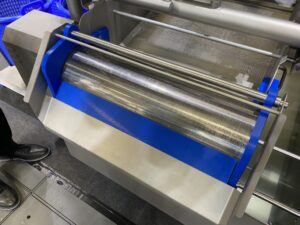Next-level clean: Kronen designs focus on hygiene
Improving hygiene and limiting the development and spread of harmful bacteria is an integral part of new food processing equipment development. German manufacturer Kronen puts hygienic design at the forefront of the processing equipment it develops.
The new HEWA 3800 washing machine is no exception. General Manager Russell Quandt explained what factors were considered during the design phase and how individual features combine to take the washing machine to the next level of hygienic design.

The HEWA 3800 is an all-purpose, helical washing machine designed for continuous pre-washing, washing, disinfection, mixing, treatment and rinsing of lettuce, other vegetables and fruit. The machine is a step up from an earlier model, the GEWA 3800 PLUS.
Similar to the earlier model, HEWA 3800 has the capacity to process 2,500 kilograms (or around 5,511 pounds) of product per hour. Where it deviates, though, is its focus on the most advanced hygienic design technology.
“To do the things we wanted to do to improve the GEWA turned out to be a whole new machine,” Quandt said in an interview at Fruit Logistica 2023 in Berlin, where the HEWA 3800 was launched. “The performance of it is just as good or better. The reliability is the same, the usability is the same. But putting all these new innovations for a higher hygienic level of design and ease of cleaning just required a new model.”
Kronen’s first aim was to improve the washer’s water management system. Its experts believed that the best way to enhance hygiene was to improve access to the machine’s inner workings.
Most processors face extreme time constraints when it comes to sanitization. Oftentimes, sanitation is the responsibility of an outside cleaning crew that comes in during the wee hours of the night. Turnover within these companies can be high. The easier it is to dismantle the equipment, the more often it will get done, Quandt explained.
“Access makes it happen,” he said.
The HEWA 3800 washer can be quickly and easily dismantled for rapid and thorough cleaning without the use of tools. The manufacturer also developed new nozzles for the HEWA 3800. Traditional nozzles are designed with multiple parts. Not only are they difficult to take apart and clean, but the small parts are easy to misplace.
“Our nozzles are now made out of one piece. They’re machined, not assembled,” said Quandt. “Now you can truly get to the backside of a nozzle rather than just spraying the outside.”
All corners were eliminated in the design of the new washer as well. Whereas tight angles provide spaces for bacteria to settle, surfaces of either 45° or 120° angles allow for optimal discharge, reducing the risk of bacterial buildup and biofilm. The framework of the HEWA 3800 is now completely rounded, which limits surface area where bacteria can build up.
Kronen has also eliminated the use of plastic strips that were once bolted on. On older equipment, those parts had to be manually dismantled and removed for cleaning, a job that required a specific set of tools. Now the pieces are machined and removeable without the need for tools.
Cabling on the HEWA 3800 is now exposed rather than hidden in piping. Bundles of no more than three cables now run through eyelets underneath the machine. Being out in the open allows for regular and proper cleaning.
On more traditional models, this task was often missed. The cables were inaccessible to the teams who cleaned the equipment, but not to bacteria. Kronen also completely redesigned the water filtration system for removing fine particles for the HEWA 3800.
“It’s simpler and requires no tools to pull it apart,” said Quandt.
The vibratory discharge was also redesigned. It’s now a one-piece welded assembly with sanitary design, meaning there are no pockets or capture points where bacteria can build up. It can be easily removed for cleaning by releasing two clamps. Again, no tools are needed to disassemble the equipment.
As it is one of the dirtiest parts of the machine, providing quick and easy access is crucial to ensuring that the equipment is thoroughly and regularly sanitized, said Quandt.
Kronen uses Aisi 304 stainless steel in the construction of its vibration motors, pipelines, wash and pump tanks, pump casing and switch cabinet.
While the individual changes might seem small, when combined, the result is a versatile machine with a focus on improving and maintaining the highest level of hygiene.







